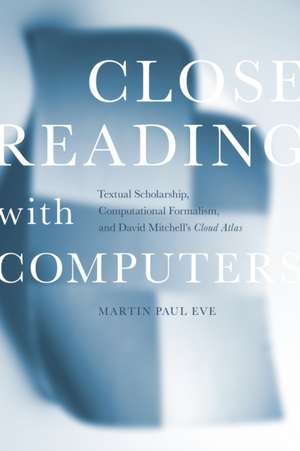Close Reading with Computers – Textual Scholarship, Computational Formalism, and David Mitchell`s Cloud Atlas
Autor Martin Paul Eveen Limba Engleză Hardback – 3 iun 2019
Preț: 704.31 lei
Preț vechi: 869.52 lei
-19% Nou
Puncte Express: 1056
Preț estimativ în valută:
134.77€ • 139.04$ • 112.47£
134.77€ • 139.04$ • 112.47£
Carte tipărită la comandă
Livrare economică 27 martie-10 aprilie
Preluare comenzi: 021 569.72.76
Specificații
ISBN-13: 9781503606999
ISBN-10: 1503606996
Pagini: 272
Dimensiuni: 160 x 235 x 24 mm
Greutate: 0.54 kg
Editura: MK – Stanford University Press
ISBN-10: 1503606996
Pagini: 272
Dimensiuni: 160 x 235 x 24 mm
Greutate: 0.54 kg
Editura: MK – Stanford University Press
Notă biografică
Martin Paul Eve is Professor of Literature, Technology, and Publishing at Birkbeck College, University of London. He is a winner of the 2019 Philip Leverhulme Prize, sponsored by The Leverhulme Trust
Cuprins
Contents and Abstracts
Introduction: Close Reading, Computers, and Cloud Atlas
chapter abstract
This introductory chapter outlines the history of close reading and its perceived conflict with new distant-reading techniques. Focusing on the controversies that have surrounded the digital humanities with respect to close textual attention, this chapter argues that, in fact, distant- and close-reading paradigms are not so far separated as one might believe. As well as introducing the text on which the book is centered, this chapter also outlines the overarching metaphors of the entire book: the computational microscope and close-textual digital microscopy.1The Contemporary History of the Book
chapter abstract
This chapter shows that, in 2003, David Mitchell's editor at the US branch of Random House moved from the publisher, leaving the American edition of Cloud Atlas without an editor for approximately three months. Meanwhile, the UK edition of the manuscript was undergoing a series of editorial changes and rewrites that were never synchronized back into the US edition of the text. When the process was resumed at Random House under the editorial guidance of David Ebershoff, changes from New York were likewise not imported back into the UK edition. This chapter uses a range of visualization techniques to document the substantial differences between the editions.2Reading Genre Computationally
chapter abstract
This chapter considers what it means to appraise genre with the aid of computers. For David Mitchell's Cloud Atlas contains six different and distinct generic registers. The first segment in this chapter explores the assumptions and limitations of computational stylometry. The second part examines computationally the linguistic mechanisms that create Mitchell's genre effects. The third part compares the seafaring parts of Mitchell's novel with the writings of Herman Melville, using Burrows's delta method. Finally, this chapter turns to a part-of-speech trigram visualization and analysis to pinpoint how the microlinguistic changes throughout this text contribute to the genre effects of each section.3Historical Fiction and Linguistic Mimesis
chapter abstract
This chapter asks what it can mean to write as though in some bygone period. Specifically, this chapter addresses issues of mimetic accuracy in historical fiction that purports to come from a particular time frame. For the first section of Cloud Atlas purports to be set around 1850. This chapter argues, though, for the construction of a stylistic historical imaginary of this period's language that is not based on mimetic etymological accuracy. Using word-dating tools, I argue that there are political implications to the "puncturing" of linguistic accuracy in this chapter for our consideration of the novel and its colonial rhetorics, a fact that I consider by cross-comparison of word frequencies with the COCA text-base.4Interpretation
chapter abstract
This final chapter takes the preceding computational analyses in the book and synthesizes the results into a close reading of Cloud Atlas that focuses on the idea of the object-mediated "archive" as central to the novel's depiction of alternation between the historically unique and the pattern-making efforts of historiography. In terms chapter 1's analysis of textual variance, this chapter notes that the section with the most obvious alterations is the part of the narrative where an archivist attempts to store the voice of a death-penalty convict for posterity. Yet, in the novel's transtextual variance, these editions are different, thereby undoing the preservation effect that such an archive is supposed to have. Finally, this chapter argues that Mitchell's novel contains within it a clear critique of Francis Fukuyama's well-known "end of history" thesis.Conclusion
chapter abstract
This chapter briefly remarks on the future of textual studies and digital approaches to the close study of literature. It closes the book by noting the media storms that are whipped up around the claimed digital "threat" while also pointing out that, in fact, the garnering of empirical evidence has been a long-standing feature of close reading and that computational methods can help us to see a work more clearly.Descriere
Rather than working at the usual scales of distant reading, this book shows what happens when we bring techniques from the digital humanities to bear on a single novel for close readings.
